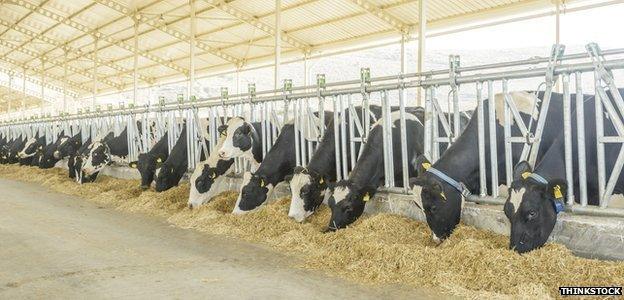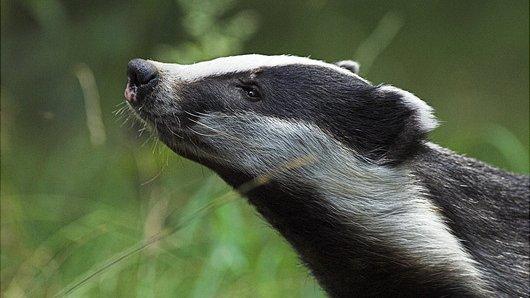Radical plan needed to stop spread of cattle TB - study
- Published

New research suggests that the spread of TB in cattle can only be controlled if more radical measures are adopted.
Culling of entire herds, more testing and cattle vaccination are needed to reverse the spread of the disease.
The lead researcher has told BBC News that the study also confirms research that shows culling badgers will at best slightly slow down rather than stop the epidemic.
The results have been published in the journal Nature.
Prof Matt Keeling of Warwick University, who led the research, told BBC News that computer projections showed that the current measures adopted by the Department for Environment, Food and Rural Affairs (Defra) are unlikely to reverse the spread of TB in cattle.
"Our feeling is that we are going to see a continued increase of 10% per cent a year into the foreseeable future," he said.
Lord Krebs, who developed much of the scientific underpinning to assess the effectiveness of culling badgers to control the spread of TB in cattle said that the study's conclusions "give further support to the view that culling badgers is not an effective strategy for controlling bovine (cattle) TB".
"Instead, the emphasis should be on stopping cattle-to-cattle transmission. It is to be hoped that Defra takes on board this latest piece of scientific evidence when they formulate their policy for the future," he added.
Defra said it could not accept the paper's findings because it "does not investigate the full range of ways in which TB could spread". A spokesman said a whole herd slaughter when an infection was discovered would mean killing up to a quarter of a million animals, most of which would not be infected.
The Farming Minister George Eustice said: "What this paper proposes would finish off the cattle and dairy industry in this country."

Culling badgers will have a small impact on controlling the spread of TB in cattle
That was a view echoed by the department's chief scientific adviser Prof Ian Boyd. He said that whole herd culling "would probably result in a rapid decline in the cattle industry in areas where TB occurs".
He added though that he believed the study backed Defra's current TB control strategy which, he said, is "designed to cope with complex and diverse routes of infection."
Prof Keeling and his co-author, Ellen Brooks-Pollock from Cambridge University, said that Mr Eustice and Prof Boyd had misunderstood the point of the study.
In a joint statement they said: "Whole herd culling was investigated as one extreme but was never put forward as a viable policy option."
Firm figures
The aim of the study, they say, is to give Defra some firm figures with which to begin a new cost benefit analysis. This would assess whether any of the approaches, or a combination of them, might be worth trying.
For example, a combination of whole herd culling in hotspots where there is frequent TB infection combined with vaccination, as well as more testing and individual culling might be enough to bring about a reversal in the spread of TB.
Defra is trying to stop the spread of the disease by testing cattle in infected areas and culling only those that are found to be infected. In addition, herds that have had a case of TB cannot be transported from their farm until two further tests have shown them to be free of TB.
The problem is that the current test often does not pick up animals that are in the early stages of infection. This is why the disease continues to advance slowly but inexorably, devastating the livelihoods of dairy farmers as it spreads across the country.
Last year, approximately 30,000 animals were killed, with testing, slaughter and compensation estimated to have cost the taxpayer about £100m per year.
It is for this reason that Defra began two pilot studies last year to assess whether it could cull enough badgers humanely and safely to help curb the disease. TB-infected badgers are thought to be one of the ways the disease is spread to cattle.
An independent analysis for Defra judged that the pilots had failed to kill enough badgers to have any impact on TB infection and that an excess of badgers took too long to die. The department hopes to improve the effectiveness and humaneness of the culls going forward and roll the badger cull policy out to more TB infected areas.
Prof Keeling and his team created a detailed computer model to mimic the observed spread and assess the effect of more radical control measures. The researchers found that only three would have any significant effect.
Real impact
The model was not able to specifically look at the impact of culling badgers, because there is not enough information about their location, infection and movement. However, the team included an all-encompassing factor to represent infection from environmental effects which includes wildlife.
"Even if you could cull humanely and effectively large numbers of badgers, it is predicted to have a relatively small impact on controlling the number of TB cases in cattle," Prof Keeling told BBC News.
"At best, the reduction in cases would be limited," he said. Prof Keeling's finding is in line with the assessment made by a large scale study carried out in the 1990s known as the Randomised Badger Culling Tria, externall.
But stepping up culling of potentially infected cattle would have a dramatic impact, according to Prof Keeling's model.
If the entire herd is culled once an infection is found, rather than just the animals testing positive for TB, the number of infected cattle across the country could be reduced by more than four-fifths in six years. The disadvantage of this approach though is that there would be mass slaughter of animals in the early years.
This would have a devastating effect on the livestock industry and the cost of compensating farmers could be up to £900m in the first year, estimates Prof Keeling.
Another effective option is to test cattle for TB more often. The model suggests that, had there been just one extra round of tests on each farm in 2005, the number of TB cases would have been cut by nearly a quarter by 2010. The downside of this approach is that testing is expensive and initially this strategy would identify more cases, making it appear that TB was increasing which might be politically embarrassing.
Defra has introduced more testing since the study was carried out but, according to Prof Keeling, it is likely that the effect of the new tests will be to slightly slow the advance of TB in cattle rather than stop or reverse it.
"We expect the additional testing to have brought about a slight decline in the rate of increase, but it does look like we need to start thinking a bit wider about how we are going to reverse the spread of this infection and bring it under control," he told BBC News.
The third approach is to vaccinate cattle, which might stall, though not reverse, the increase in TB cases. The disadvantage of this approach is that current regulations forbid the sale of vaccinated cattle.
The National Farmers Union's deputy president Minette Batters said: "No one has ever said culling badgers alone will eradicate bovine TB but we believe wildlife control in areas where TB is endemic along with cattle testing, strengthened cattle movement controls, vaccination of both badgers and cattle when available and where appropriate, and improved biosecurity must be an essential part of any eradication strategy if we are ever going to get rid of this terrible disease."
Dominic Dyer, chief executive of the Badger Trust and a policy advisor to campaigners Care for the Wild, said: "It is now time for the government to call an immediate halt to all future badger culls and to move its focus to the gaping holes in its cattle management policy, which this report shows has allowed TB in cattle to spread."
Follow Pallab on Twitter, external
- Published28 September 2012
